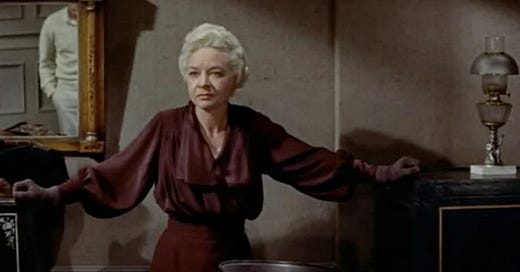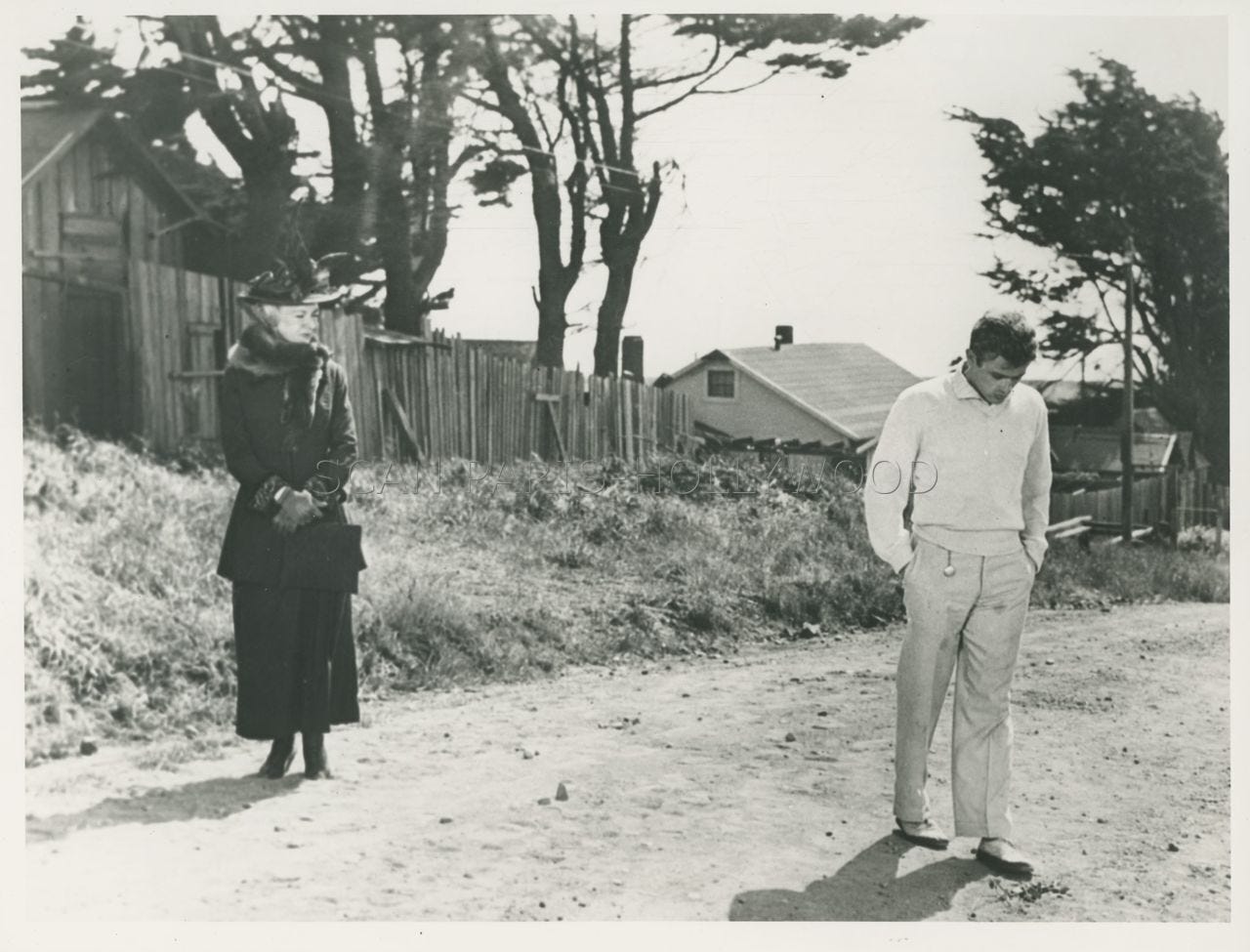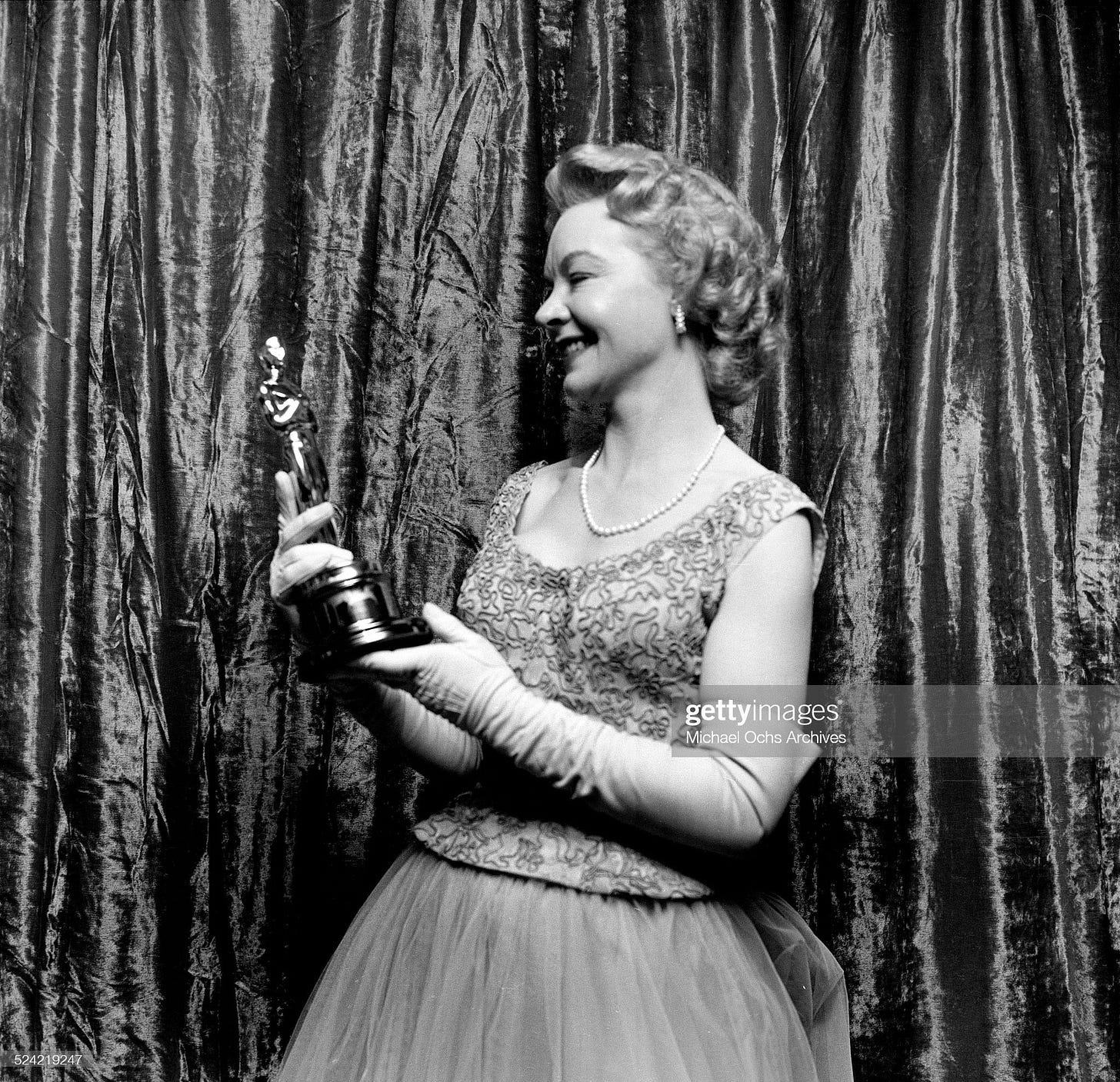Jo Van Fleet and the Better Organs of Elia Kazan
Deconstructing Jo's performance in EAST OF EDEN
I trusted Elia Kazan with everything and anything. Gadg, the Gadget Kid; the miracle worker. He was magic, he really was. His vision was so….acute. That’s it. He could see through people and scenes and situations. He never had any desire to fuck me, so our relationship was entirely professional, clean, straightforward. Peer to peer. I think his dick got in his way a lot, but as my husband told me, I got the better organs of Elia Kazan: His brain and his heart.
I was only forty, so at first I was a little offended. I was used to playing older women on the stage, but here I was going to be forty feet wide, old and pinched and mean. Shut up, Kazan said. You’re going to do the part. An asshole at Warner Bros. told me that Bette Davis was mentioned for the part. She was thinking of moving into supporting parts. I was terrified, right up until the lights were set and I was in a costume, that Jack Warner was going to walk in and fire me and bring on Bette Davis! Well, she was dumb and said it was too small a part for her. Thank God!
Gadg told me that my character was dead, a ghost, a haunting and a haunted woman. He got Anna [Hill Johnstone, the costume designer] to put me in mourning clothes—black, unforgivingly tight, pressed. I couldn’t move in those fucking clothes! Tight black gloves. I think only a child or a geisha would have been comfortable in those gloves. A veil, of course, to discourage people looking and seeing anything, but also a wall, a separation of this woman from the world. And another accessory of death. Gadg said I was present daily at my own funeral, and I could smell the rot of my soul and my flesh. Look at my lips and my nose: I’m recoiling from the smell of myself; the smell of what I have become; of all that I’ve killed.
The scene with Jimmy [Dean] on the street is like a duel, and Gadg was strict at keeping us at distances. I never get too close to Jimmy until I notice that he’s giggling at something I say about his father, my former husband. This comment draws them together. I see that I am his mother, and I like him. I’m attached to him. He’s got sense like I do. Then I turn and we are together in the reflection of the mirror. Related. One. God, Gadg was a great director
My physicality was determined by the text. I believe in the text. Gadg would have me learn the lines completely, then forget about them and, in rehearsal, improvise a bit. Gadg says to me that he notices that when I’m told something I don’t like or that hurts me, my back and my neck get going. I propel myself into action from the gut and the head. So when Jimmy asks me why I shot his father and left the family, I propel myself from that chair, and I defend my actions. He tried to hold me down! I yell. Well, no one holds me down. The memory of this disgusts me, so I improvised the scene where I throw something in the stove or furnace and slam the little door. Gadg was furious, because I fucked up the shot: I went out of frame. He told me the action was good, but we had to do it again to get it in the frame. And I did it. He never asked me why I did it. He knew. I was angry at myself for feeling for this kid; for opening up to him. For confessing to him. I was covered again in guilt at abandoning him. I hated it so much, so I started agitating to do something, so I went to the fire. Burn it away. Destroy it. That was a good move, and Gadg saved it.
If you wear tight gloves and clothes that refuse to give, your movements are pretty damned limited, and that’s what Gadg wanted. The dead woman is constricted, confined. I soften at a distance with Jimmy. My arms are opened. The clothes I’m wearing beneath all that black are a tiny bit more forgiving, but all the clothes are a punishment. Drab and denying this woman of her past, when she was beautiful. The skirt is tight, but the blouse is a little loose, because the tits have gone and there’s business to hide that, and I’m kinda sizing the kid up, flirting. I started to twirl the chair when I softened toward Jimmy. The chair from which I’d leapt, as if to strike him, is now a toy, a swinging leg, an twirl of the hair, you know? Later, I really soften when I’ve given him the check and I feel—I know—that he’s a good kid. It’s like weights are dropping from my face and my shoulders. I love this boy.
I think I’m the only one who thought the line about going to college was funny. I think even Gadg just saw it as a shot, a criticism, meanness. I saw it as a perfect reaction to the fact that I run a whorehouse and my money is going to save his Bible-reading Puritan father, and I think that if he doesn’t find this funny, he’s wasting his time in college, because he’s dumb. I saw the film in theatres a few times, and the audience always laughed or chuckled at that line. They got it. Gadg told me that when I was right, I was right.
I don’t like my face. I hate how I look, but I really hated my face in that film, even though I devised the makeup. No color. Flat and matte. Sneering. Right before we shot a scene, I checked my makeup in a mirror because I sweat in the face a lot, and after I looked and repaired, I turned the mirror down. A rejection of what I’d seen. That stays, I told Gadg, and it did. The room has almost no color. It looks intentionally like a back room, a comforting station, at a funeral home. The walls, the bedspread, the lamp shade—all the color of corpse skin. Out front there’s the pink of nipples and pussy, men drinking, the yellow of beer, Lois Smith’s red lips and natural, beautiful coloring. But in the back? Death. No air. Nothing.
Words are direction. Gadg really didn’t tell me too much about to where to go or what to do. I had the script, the biography of the woman I was playing. He marked our space and told us to stay within it. Jimmy gave everything over to me. He did. He was very sweet. No ego at all. When we finally got the scene completed in that back room, he gave me a very deep, courtly bow. The crew applauded. Gadg? What? You want praise? I told you you could do it.
Props are important, and the check writing scene and the presentation were important to me. I get really pissed when people say the envelope doesn’t stay sealed. Well, yeah, asshole, that was planned! It was also my plan to stab the pen into the ink again, to show how she doubts what she’s doing, that she’s angry about giving this money to help her hated ex-husband. She’s stalling. The tearing of the check isn’t clean, because I am not clean, so there is a ragged edge to the check. This was all worked out. People are so stupid.
I got news of the Oscar nomination, and I knew I wouldn’t win. Betsy Blair [of Marty] was the female lead, and they had put her in supporting. She had won Best Actress at Cannes. Peggy Lee was getting raves [for Pete Kelly’s Blues] and she had money and was campaigning a lot. So I just knew I didn’t have a chance. I loved my part, and I was good in it, but it was too small.
About a week before the ceremony, Jack Warner calls me and tells me to go see Helen Rose, a brilliant costume designer, to get a proper dress for the Oscars. I had bought a nice, serious frock, but Jack said no, I was going to win and go up on stage, and I needed a proper dress. I told him I wasn’t going to win, and he said, Look, who the fuck are you talking to? I know people; I have sources; you won. I was stunned.
I called Gadg and he told that the year before, his producer Sam Spiegel [on On the Waterfront] had called and told him all the Oscars they had won. He had a source. They paid people off, I don’t know who, and they would call and tell you what looked good. So I went to see Helen Rose, and she made me a lovely dress, and I won. It was the happiest night of my life. I deserved it. I haven’t had many happy nights since.
Actress Barbara Baxley, a close friend from their young ages in Stockton, California, remembers all the glossy photographs of Jo with her Oscar. “It was the summit,” Barbara told me, “and then things fell apart. Jo expected so much, and nothing arrived.”
Jo Van Fleet carried her Oscar around the city of New York, using it as identification, placing it on tables in the diner where she ate, showing it to booksellers on Broadway, to nursing staff at St. Clare’s Hospital, where she visited her dying husband. “This is who I am!” she would say.









